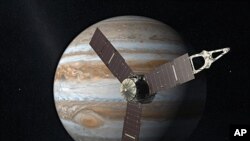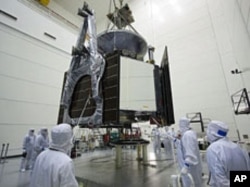NASA will launch a spacecraft toward Jupiter next month with the goal of learning more about the massive planet and, in doing so, learn more about the way our own planet was formed. The Juno mission is set to liftoff from the Kennedy Space Center on August 5.
As far as planets go, Jupiter is impressive in terms of scale and age.
"Jupiter probably formed first," Scott Bolton, a scientist at the Southwest Research Institute in Texas, explained. "It's the largest of all the planets. In fact, it's got more material in it than all the rest of the solar system combined. If I took everything in the solar system, it could all fit inside Jupiter. And, in fact, Jupiter is probably more than twice as massive as the rest of the solar system put together."
Those points alone could make researchers want to send a spacecraft beyond Mars and the asteroid belt to the fifth planet from the sun. But there is an even more compelling reason.
Bolton says that after the Sun formed, Jupiter got what he calls "the majority of the leftovers."
"We want to know that ingredient list. What we're really after is discovering the recipe for making planets, and we're back at the first step of making sure we have all the ingredients in that recipe," said the scientist.
So NASA is sending the Juno spacecraft to Jupiter to suss out those ingredients and to answer some key questions about the way Jupiter - and the solar system - evolved.
Bolton is the principal investigator in the $1.1 billion Juno mission. The goal is to study Jupiter's magnetic and gravity fields, as well as the composition of the planet's core and its atmosphere.
Like any cook following a recipe can tell you, it is important to know how much water goes into the mix. "We want to know how much water is inside Jupiter, which represents how much oxygen. Oxygen is the third most abundant element in the universe and in the Sun, so it's a big missing piece if we don't understand it," said Bolton.
He told reporters at a mission preview briefing Wednesday that water is a varying factor in many theories about the way planets formed. He said by knowing the amount of water in Jupiter's planetary recipe, scientists can rule out some existing theories of planetary evolution.
Bolton says Juno is energy efficient and it pushes the boundaries of solar power. The spacecraft will be further from the Sun than any solar-powered mission before it. There is 25-times less sunlight near Jupiter than there is here on Earth. Once it is near Jupiter in 2016, Juno will be generating about 400 watts of power, which is not enough to run a hairdryer.
To make the most of the Sun, Juno has three giant solar rays. The craft will essentially cartwheel through space for five years, until it is about 5,000 kilometers above Jupiter's cloud tops. Bolton says Juno will dip down below the planet's radiation belts, which he says are among the most hazardous spots in the solar system.
The craft's electronics will be inside a vault to protect them. "We're basically an armored tank going to Jupiter," said the scientist.
The Italian Space Agency, as well as partners in Belgium, France and Denmark, contributed components to the Juno craft and instruments.
Juno is set to orbit Jupiter for one year, starting in July 2016.

